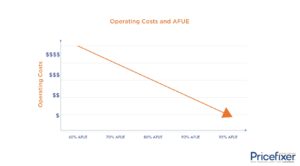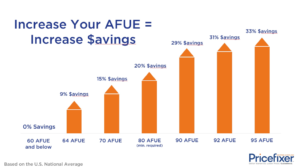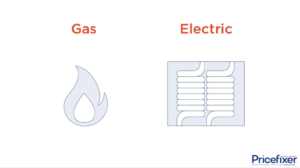Heating and Cooling Systems Explained- Your Best Guide to the 3 Types
When you’re in the market for a new air-conditioning or heating system and trying to determine which of the heating and cooling systems is the best for your home, it’s easy to become overwhelmed by the number of different options, types of systems and selections available. If only there was one place that easily explained the main types. Well, you’ve come to the right place! In this article, we are going to provide an overview of the three main categories of heating and cooling systems and discuss in detail the differences and benefits of each in order to help you make the best decision for your home, your budget, and your lifestyle.
Overview of the three main types of air conditioning systems
The three most common types of air conditioning systems are split systems, package systems, and ductless systems. Split systems are the most popular type of air conditioners found in U.S. homes. Just as its name implies, this system is “split” into two main components with one part located inside the home and the other housed outside the home in a metal container. The indoor component is connected to a network of ducts and uses a blower to circulate cooled air throughout the various rooms of the home. The outside component contains a condenser coil and a compressor, which pumps the refrigerant into the system.
A packaged unit works just as a split system does by moving cooled air through a network of ducts, however, instead of an indoor and outdoor unit, the evaporator coil, condenser, and compressor are all housed together in one metal-encased “package” that’s usually located outside the home.
Ductless systems, also known as “split ductless” systems, provide cooling similar to central air conditioning systems only without the use of ducts. These types of systems have an outside component with a condenser that circulates refrigerant via tubing to indoor blower units located in separate rooms. This type of system is particularly useful for homes that don’t or can’t install ducts.
Each of these air conditioning systems are effective in cooling homes during the warmer months of the years, but looking a little more closely at each will help you determine which system is the best one for your home.
Click here to watch the PriceFixer explainer video of the three types of heating and cooling systems. It can be super helpful to see a visual description of each!
What is a Split System?
A split system has an outdoor component with a compressor that pumps a liquid refrigerant through copper pipes (refrigeration lines) to the indoor component. The indoor component, usually located in a closet, crawl space, or attic, contains an evaporator coil that absorbs heat from the air, thereby cooling and dehumidifying it. Using a blower, also known as an air handler, this cooled air is then pushed into multiple areas of the home via a system of ducts and vents effectively lowering the interior air temperature. Simultaneously, warm air is being drawn out of the rooms through return air ducts.
The heat that was absorbed by the evaporator coil is then pumped back out (as a vapor) to the exterior unit that houses the compressor and condensing unit where it is it condensed into a liquid state so the cooling cycle can start all over again.
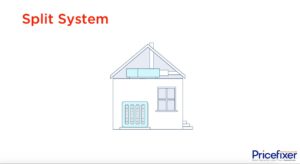
Split System Pros:
- Since half of the AC system resides indoors, its interior components are protected from harsh weather conditions, which will prolong their life. As long as you change the filter regularly and perform routine maintenance, the evaporator coil and fan should last a long time.
- Higher energy efficiency options. Split systems come in a wider range of SEER ratings, going as high as 18 SEER and above, which means superior energy savings.
Split System Cons:
- Larger system takes up a lot of space.
- More complicated installation – with two separate components, indoor and outdoor, the chances of faulty installation doubles. Incorrect installation will reduce a split system’s efficiency and its life span.
- More difficult to repair as there is an outdoor and indoor section, the latter oftentimes being in tight or hard to reach places.
What is a Packaged System?
With all of the main air conditioning components conveniently housed together in a single casing, a packaged unit operates in the exact same way as a split unit does, with the transference of a refrigerant between the evaporator coil and condensing coil, delivering cooled air via ducts throughout the home. Typically located outside next to the house on a concrete slab, or on the roof of a house, packaged units are much smaller than split systems and are an excellent option for space-challenged or smaller abodes.
Split systems and packaged units are what’s known as “central” air conditioning systems because they use a network of ducts, typically hidden behind walls, under floors, or above the ceilings, to circulate cool air throughout the home. The ducts are made of sheet metal and conveniently work with furnaces and heaters to distribute warm air throughout the home as well.
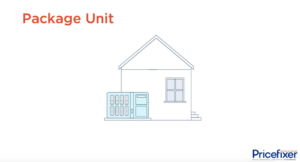
Packaged Unit Pros:
- All components are already factory-assembled and tested which allows for easy installation and proper functioning once its installed.
- Smaller size takes up less room. Packaged units can even be installed on some roofs, for extra space saving options.
- All of the components are located in one place which makes it easy for maintenance and repairs.
- A quieter home – since there is no indoor component, your peace and quiet inside the home won’t be disturbed. The air handlers of some older split systems could develop annoying noises over time.
Packaged Unit Cons:
- All of the sensitive electronic components are located outside exposed to a harsh environment. Exposure to the elements could cause rust, damage, or other problems that could hinder the operation of the unit. Also, curious animals often burrow or chew their way into the unit causing damage as well, which leads to a life span that is likely to be shorter than that of a split system.
- Lower SEER options. Packaged units don’t offer high SEER options like split systems do, but rather only go up to 16 SEER.
What is a Ductless System?
A ductless air conditioning system cools your home in a similar fashion as a ducted, central air conditioning system, only without the ducts. It does this by having an outdoor unit pull heat from inside your home while indoor air handlers, typically mounted high on the wall of a room, blow cool air into each individual room. Just like a split, central air conditioning system, a ductless system has an outdoor component that contains a condenser, compressor, and evaporator. Unlike the split, central AC system, however, instead of one air handler tucked away in a closet, smaller, individual air handlers are installed in individual rooms and the air temperature of each room is controlled by the air handler unit in that room. Connected to the outside component by cables and refrigerant lines that only require a small hole in the wall to pass through, the air handlers are able to effectively distribute cooled air without the need for ducts. Ductless systems are also capable of distributing warm air.
Ductless systems are growing in popularity and are a great option for homes that don’t have ducts already installed and the idea of tearing up the walls to install them is undesirable, or if a home simply doesn’t have the space to install them. A great benefit of ductless systems is that they avoid the energy loss typically associated with ducted systems. More than 30% of energy can be lost due to ducts, especially if they are in an unconditioned area, like the attic. Ductless systems also have the added benefit of individualized air control for each room; if one person prefers a room temperature of 78 while another person prefers their room temperature to be 72, then this system offers that type of flexibility. Ductless systems do tend to be more expensive than central air conditioning systems, but avoiding the cost of installing ductwork would lighten the expense.
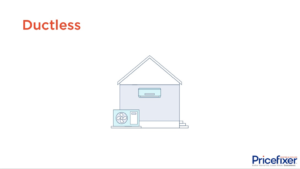
Ductless system pros:
- No ducts required
- Extremely energy efficient
- Flexible air temperature control for individual rooms
- Easier to install than larger, central air split systems with connecting ducts
- Less dust as there are no ducts, which collect dust that gets circulated through the air
Ductless system cons:
- More expensive than traditional AC systems
- Air handler mounted on wall may look obtrusive
- Installation more expensive as each indoor unit must be correctly sized and placed
Check out the video overview of three types of systems.
Now that you know what they are, where can they be located within your home or business?
Of course, a certified professional contractor can help you determine the best location for your new air conditioning system, but listed below are the common locations for each type of system.
Common locations of Split Systems
To avoid extra long ducting, which could reduce efficiency, it’s best to install the indoor unit in a central location within the home. Some common places include utility closets or an enclosed space within the garage. Putting the air handler in the attic is not ideal as that area is prone to extreme heat and reaching the system for repairs or to change the filter may be difficult. For the outside component, it’s best to place it in an area that avoids direct sunlight and has plenty of clearance on all sides, with two to three feet of space on all sides and five feet or more of unobstructed space above the unit.
There are 5 areas within the home where the unit could be oriented.
- Attic
- Garage
- Crawlspace
- Basement
- Closet
Common locations of Package Units
Just like the outdoor component of split systems, packaged units should be installed outside the home in an area with plenty of clearance on all sides. Common locations include placing the unit on a concrete slab near the foundation of the house, or, if space is really limited, packaged units can be installed on some roof types, freeing up more yard space.
Common locations of Ductless System
The air handlers placed indoors are compact and sleek looking and their design can be aesthetically pleasing. Additionally, they can be mounted in a variety of locations such as on the wall just above eye level, in the ceiling, and near the floor.
Lifespan Comparisons
Extreme weather conditions will of course affect the life span and operational efficiency of any type of air conditioning system, as well a lack of proper maintenance, but under typical U.S. weather conditions and routine maintenance, the lifespan of a packaged unit is around 12-15 years. The life span of a split system is around 15 years, a bit longer than that of a packaged unit due to half of the system being located indoors in a controlled environment. The average life span for a ductless system is 20 years, as the lack of ducts also means a lack of dust, dirt and debris collecting within them that could potentially damage important system components.
Clear signs it’s time to replace your air conditioner
Now that you’re more educated about the different types of heating and cooling systems available, you can make a smart decision about the best option for your home when it comes time for you to replace your current system. How will you know when it’s the right time to replace your old AC unit? There are several key indicators you should be on the lookout for that will let you know when it’s time to throw in the towel and get yourself a new air conditioner. Remember, if you keep putting money into repairing an older unit, you will be losing out on the cost saving features that today’s newer, more energy efficient models provide.
- Your air conditioner is over ten years old. Even if it could go another five years, the savings you’d see with a newer, more energy efficient system makes it worth your while to replace the older unit now.
- High repair cost. If you’re facing an expensive repair, it makes sense to put that money towards a newer, more efficient unit instead which will save you money on your utility bill.
- Repairs aren’t expensive but they’re frequent? If your AC unit is constantly breaking down then those small repairs can start to add up. Save yourself the aggravation and invest in a new unit.
- Your air conditioner still uses R 22 Freon. Not only is this hydrochlorofluorocarbon (HCFCs) one of the worst pollutants and ozone-depleting substances in existence, but it is being phased out by the government to conserve energy and protect the environment. All air conditioners will eventually switch over to only using the new R410A refrigerant; help the environment and replace your old unit now.
- Loud noises. Rattling, shaking, grinding, clicking and general cacophony are sure signs your air conditioner is in distress. Newer models are much more technologically advanced resulting is quieter operation and better comfort.
- Excessive dust. If you see a lot of dust in your home, even after cleaning, it could indicate a leak in your ductwork. Leaks in the ducts cause the system to work harder and less efficiently, increasing your operating costs.
- Diminished air flow. If there is little to no cool air blowing out of the vent, then there’s likely a problem with the compressor.
- Hot spots or difficulty keeping your home cool. This could be a sign of an improperly sized system or an aging air conditioner. Either way, an air conditioner should adequately cool your home, if it doesn’t, then replace it with one that does.
- Your monthly utility bills have dramatically increased. If your energy consumption has spiked and there’s no obvious reason why, then the culprit could be an inefficiently operating heating or cooling unit that’s nearing the end of its working life.
Conclusion
So, you’ve decided to purchase a new HVAC system – aren’t you glad you read this article? You are now well-informed about the options available to you that will help you choose the perfect system for your home. Let’s review:
The three main types of air conditioning systems are:
- Split Systems
- Packaged Units
- Ductless Systems
Split systems and packaged units are both known as central air conditioning systems because they force air through a network of ducts to distribute cooled air evenly, and “centrally,” throughout the home. The difference between a split system and a packaged unit is the split system is much larger and has an indoor component and an outdoor component. Packaged units take up less space as the main components are combined into one convenient “package” located outdoors.
A ductless system provides cooling for the home with multiple air handler units installed in individual rooms and does not require the use of ducts.
Ductless systems and central air conditioning systems are both excellent choices for cooling a home. Not sure which type of system is right for you? Here’s a look at the pros and cons of a “forced-air” system (central air) and a ductless system:
Central air conditioning pros:
- Effective and efficient cooling of your home, particularly large spaces
- Ducted systems are better at controlling humidity levels
- Better air circulation throughout the home
- Cleaner air due to the use of air filters which remove airborne particles and pollutants
- Combined heating and cooling; the ducts used for cooling can also be used for heating
- High SEER rated units available
- No obtrusive air handlers; ducts are hidden behind the walls and vents are inconspicuous which is aesthetically pleasing to some
- Easier maintenance; a ducted system has just one outdoor component and one air handler, unlike ductless systems which have an outdoor component and multiple air handlers, each of which require maintenance.
Central air conditioning cons:
- Ducts are necessary and must be installed if not already present
- Installation can be complicated and expensive
- Moving air through ducts causes an energy loss of 30% or more
- Ducts collect dust and debris and need to be cleaned regularly
- Improper filter maintenance can spread dust and airborne particles through the air
- Blocked or partially obstructed vents can cause uneven cooling and heating
- Can be noisy as the air moves through the vents
Ductless systems pros:
- Quick and easy to install
- Ideal for homes with no ductwork
- More energy efficient than ducted systems since there is no energy loss moving air through ducts
- Individualized temperature control for each room allows for zoning capabilities which improves energy efficiency
- Improved indoor air quality – since there are no ducts to collect and spread dust, pollen, and allergens
- Low noise – with no air traveling through ducts and quiet air handling units, ductless systems are very quiet
Ductless systems cons:
- More expensive than traditional central air systems
- Reduced air flow and air circulation – since individual air handlers cool separate rooms, there is less overall air movement throughout the home sometimes leading to stagnant air
- Less effective humidity control – air handlers in ductless systems do not remove the moisture from the air as well as central air systems do
- Air handler units mounted on walls – some may find the units don’t fit with their design aesthetic
- Multiple air handlers mean more parts that need service
When choosing an air conditioning system for your home, look at the space you have available inside and outside your home, review your budget, decide the energy efficiency standard you’d like to have, and shop online to get the lowest prices for all your cooling and heating needs and local installation. If you’re looking for the best possible quote for a new system and installation, visit Pricefixer.com! Better Warranties. Lower Prices. Guaranteed.


